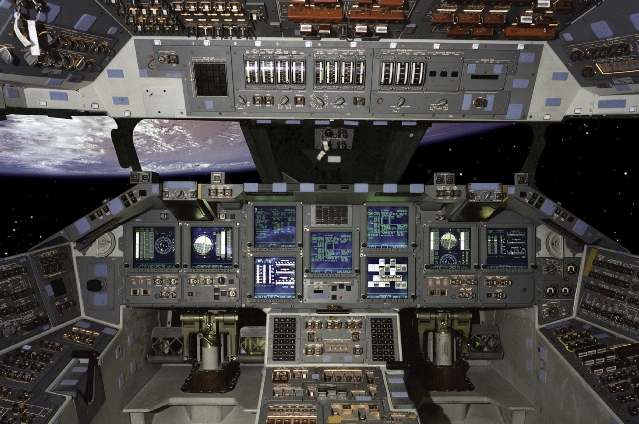This year, the Space Shuttle program will officially be retired. Due to former president George W. Bush’s Vision for Space Exploration, it will not be extended. Although this news might be sad to some, American participation in space exploration is not coming to an end. Project Constellation is taking its place and will mean many more years of space-bound missions. The history of the Space Shuttle program, however, is a long and colorful one. Despite its pending termination, this does not diminish its important contributions, not only to scientific progress but its impact on our society as well.
Although the first official Space Shuttle launch took place long after the Space Race between the US and the Soviet Union was over, it was conceived during the 1960s while Americans and Russians were scrambling to get to the moon. Then-president Richard Nixon formed a committee right as Neil Armstrong was taking his first historic steps to find a more cost-effective program for space flights. The idea was to find a viable means to perform scientific studies as well as make the shuttle available for potential commercial use, not to mention the Department of Defense’s interest in the program.

Culture and science often inspire one another. During tests of the Space Shuttle program, the first fully complete orbiter was christened the Enterprise due to a write-in campaign by Star Trek fans, taking its title from the show’s famed spaceship. Plans to dub the vessel Constitution were scrapped in favor of Captain James T. Kirk’s charge, and the Enterprise was rolled out in 1976 to engage in a series of highly successful landing tests of the ship’s design. Unfortunately for Trek fans, the orbiter was not meant for long-term use, although some of its parts were used in other shuttles.
Over the next few years, NASA produced functional orbiters in conjunction with Boeing and Lockheed Martin, starting in 1981 with Space Shuttle Columbia, then Challenger in 1983, Discovery in 1984, and Atlantis 1985. Over the next thirty years, these shuttles would house numerous scientific experiments (such as the effects of low gravity on spiderwebs), enable the launch of satellites, assist in the construction of the International Space Station, and even conduct repairs, like on the Hubble Telescope.

Things were not always easy, especially at the beginning of the program. Although repeated initial tests confirmed the relative safety of the program, Space Shuttle Challenger was destroyed due to an O-ring failure on January 28th, 1986, with a loss of all crew aboard during its launch. Seeing as how its first flight was a mere three years prior, this unfortunate tragedy ended up suspending the program for nearly three years, and NASA was criticized heavily for its reticence in discussing the issue with the media.
Moreover, despite numerous safety measures put in place after the Challenger disaster, Space Shuttle Columbia disintegrated upon reentry into the Earth’s atmosphere on February 1st, 2003. Due to the high speed of velocity at the time of the catastrophe, a search for vehicle fragments took place in three states was launched. The program was again suspended for over two years before normal flights resumed.

In addition to these setbacks, the program has been criticized as failing to adhere to its original goals. Although proposed as an inexpensive alternative to the Apollo Program, which had primarily produced rockets that were entirely disposable and expendable, the total cost of the program will clock in just shy of $200 billion by the time it is retired. Even adjusting for inflation, the program has spent well over what the Apollo or Mercury Programs did, although arguably the expense of disposable crafts has not been explored were it to continue beyond moon missions.
Despite this, the Space Shuttle program has had a significant impact on society and science. Scientifically, its ability to launch satellites from low orbit has led to interplanetary exploration via space probe, and crews willing and able to repair objects already launched completely saved the Hubble Telescope, which produces images of breathtaking beauty–not to mention invaluable data. The program has also inspired an entire generation of astronauts as well as entrepreneurs. The Ansari X Prize was a $10 million prize that went to SpaceShipOne, a privately funded and engineered reusable craft capable of reaching space.

The history of the Space Shuttle program is nearing a close, but its impact will be felt for years. After just five more missions, shuttles will no longer be the means of reaching for the stars. Fortunately, due to the countless lessons learned, the bravery of hundreds of astronauts, and the contributions of thousands of engineers and scientists, humans will still be able to grasp them.














WHY IS THE SPACE SHUTTLE PROGARM RETIRING??? WE NEED IT IT’S TO IMPORTANT TO LOSE!!
i haul the steel that went on the shuttles and the appollo space crafts we were unable to say where we going or what we had on the challenger blew up there was a reproter reporting where we deliverd the steel too what the heck is this dam if ya do dam if ya don’t think i am lieing try the steel came out of reaadding pa via bell trucking whay are we jerks stupit or what